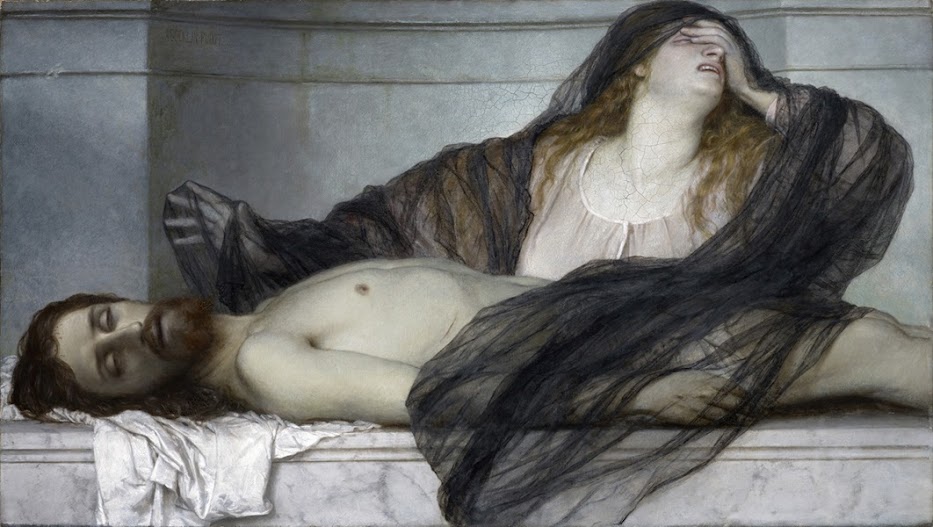Arnold Böcklin: 1827-1901 The Lamentations of Mary Magdalene on the body of Christ, c. 1868
Oil painting
Width: 119, Height: 70
Kunstmuseum Basel, Basel, Switzerland
Arnold Böcklin came up with the idea for this painting while he was in Rome. The artist finally executed the painting in Basel, where it was shown in the Stadt-Casino from January 12 to 19, 1868, and was purchased by the Basel Museum Commission during the exhibition. More on this painting
Mary Magdalene, literally translated as Mary the Magdalene or Mary of Magdala, is a figure in Christianity who, according to the Bible, traveled with Jesus as one of his followers. She is said to have witnessed Jesus' crucifixion and resurrection. Within the four Gospels she is named more than most of the apostles. Based on texts of the early Christian era in the third century, it seems that her status as an “apostle" rivals even Peter's.
The Gospel of Luke says seven demons had gone out of her. She is most prominent in the narrative of the crucifixion of Jesus, at which she was present. She was also present two days later when, she was, either alone or as a member of a group of women, the first to testify to the resurrection of Jesus. John 20 and Mark 16:9 specifically name her as the first person to see Jesus after his resurrection.
During the Middle Ages, Mary Magdalene was regarded in Western Christianity as a repentant prostitute or promiscuous woman, claims not found in any of the four canonical gospels.
More Mary Magdalene
Arnold Böcklin (born October 16, 1827, Basel, Switzerland—died January 16, 1901, Fiesole, Italy) painter whose moody landscapes and sinister allegories greatly influenced late 19th-century German artists and presaged the symbolism of the 20th-century Metaphysical and Surrealist artists.
Although he studied and worked throughout much of northern Europe—Düsseldorf, Antwerp, Brussels, and Paris—Böcklin found his real inspiration in the landscape of Italy, where he returned from time to time and where the last years of his life were spent.
Böcklin first won a reputation with the large mural Pan in the Bulrushes (c. 1857), which brought him the patronage of the king of Bavaria. From 1858 to 1861, he taught at the Weimar Art School, but his nostalgia for the Italian landscape pursued him. After an interval during which he completed his mythological frescoes for the decoration of the Public Art Collection, Basel, he settled in Italy and only occasionally returned to Germany, and then to experiment with flying machines. During his last two decades, Böcklin’s work became increasingly subjective, often showing fabulous creatures or being based on dark allegorical themes, as in Island of the Dead (1880), which provided the inspiration for the symphonic poem The Isle of the Dead by the Russian composer Sergey Rachmaninoff. Such spectral scenes as his Odysseus and Calypso (1883) and The Pest (1898) reveal the morbid symbolism that anticipated the so-called Freudian imagery of much 20th-century art.
More on Arnold Böcklin
Please visit my other blogs: Art Collector, Mythology, Marine Art, Portrait of a Lady, The Orientalist, Art of the Nude and The Canals of Venice, Middle East Artists, 365 Saints, 365 Days,
and Biblical Icons,
also visit my Boards on Pinterest and deviantart
Images are copyright of their respective owners, assignees or others.
Some Images may be subject to copyright
I don't own any of these images - credit is always given when due unless
it is unknown to me. if I post your images without your permission, please tell
me.
I do not sell art, art prints, framed posters or reproductions. Ads are
shown only to compensate the hosting expenses.
If you enjoyed this post, please share with friends and family.
Thank you for visiting my blog and also for liking its posts and pages.
Please note that the content of this post primarily consists of articles
available from Wikipedia or other free sources online.

No comments:
Post a Comment